Whether you’re a startup or a multinational business, maintaining good attendance contributes to the company’s success. It also speaks volumes about your employees’ credibility and work ethic.
Moreover, attendance impacts your workplace in several other ways. For example, tardiness or the persistent absence of one employee can negatively impact employee morale.
That’s why the importance of attendance is quite high at work.
In this article, we’ll answer the question why is attendance important at work, discuss the key factors affecting work attendance, and learn how to address employee attendance issues.
We’ll also give handy tips to employers for improving employee attendance.

Table of Contents
- Why is attendance important at work?
- 3 crucial factors that affect attendance at work
- 5 helpful steps to address employee attendance issues
- Handy tips to maintain attendance at work
Let’s get started.
Why is attendance important at work?
Maintaining regular attendance and punctuality is crucial for any employee because when a candidate accepts a job offer, they’re committing their time to the company.
Understanding the importance of attendance and showing up for the job every day lays the foundation for their successful career.
But when an employee has consistently poor attendance, it suggests that they’re not prepared to pull their weight in the company. On the contrary, good attendance reflects dedicated employees you can trust with important tasks.
However, the company must also do its part in encouraging workplace attendance and avoiding chronic absenteeism.
What’s that?
Absenteeism is a habitual pattern of being absent for any duty or obligation without any good reason. It’s a serious workplace issue that an employer should address on priority.
If you’re unsure how it affects your company, here’s what excessive employee absenteeism can lead to:
1. Poor work performance
Excessive absenteeism of one employee can force the managers to restructure workflows.
This process, however, can have a domino effect on the entire organization.
Employees with good attendance need to take over the work of their coworkers while also dealing with their own workload.
Consequently, they’ll have to rush things or increase their working hours, and the quality of work gets affected. This also affects overall employee productivity.
Moreover, a regularly absent employee may fall behind to adapt to changes, affecting their own efficiency. This can even lead to delays in services or productions, thereby affecting the customers.
2. Increased stress and lack of employee morale
Since absenteeism of an employee increases the workload of the remaining staff, it leads to work dissatisfaction.
Having to deal with additional workload along with their existing responsibilities can negatively affect employee morale.
Additionally, when overload becomes a regular thing, it leads to stress, resentment, and burnout. This can take a toll on the dedicated employees, who may have to take a day off to deal with the exhaustion.
3. Increased staff related costs
When a company suffers from absenteeism, you’re forced to temporarily hire more staff or replace an absent employee permanently to meet labor needs. Either way, hiring a new employee involves a cost that further burdens your company’s resources.
Moreover, every new employee needs time to get used to the work, leading to additional costs in terms of lost productivity.
4. Workplace ethics issues
Maintaining good attendance is also a crucial part of work ethics.
As an employer, if you don’t address the issue of absenteeism, it sends out a message that you neither uphold such soft skills nor prioritize work ethics issues.
You should reward every staff member who is dependable and disciplined. It also greatly helps to boost employee engagement.
5. Animosity
Chronic absenteeism can have an adverse effect on other employees who maintain good attendance. Co-workers can get discouraged and demotivated when a team member is frequently absent or comes late to work.
Over time, regular employee absence can lead to animosity amongst coworkers and affect employee engagement, especially when the employer doesn’t reprimand an unexcused absence and tardiness.
Now that you know the importance of regular attendance and the consequences of absenteeism, let’s look at the major factors that lead to an attendance problem at the workplace.
3 crucial factors that affect attendance at work
Here are the three significant factors that can contribute to poor attendance:
1. Presenteeism
Presenteeism is when an employee comes to work sick, exhausted, or distracted to the point that they can’t carry out their work duties.
According to the research by global staffing firm Accountemps, around 90% of professionals admitted they’ve sometimes come to work unwell. Out of these, 33% always go to work even if they’re sick.
These numbers are alarming because presenteeism can create several workplace hazards, like putting co-workers at risk of infectious diseases. This, in turn, leads to more employees seeking medical leave, affecting overall employee attendance.
Presenteeism is even more dangerous if the employee works in food service or is a healthcare professional.
2. Negative work environment
If you constantly overwhelm your employees with heavy workloads, lesser pay, and fewer vacation days, the staff may feel the pinch and act accordingly.
This can lead to the unscheduled absence of an overworked employee and more staff members calling in sick to compensate.
Moreover, a hostile work environment can also negatively impact employees’ stress levels.
As a result, frustrated and demotivated employees can resort to tardiness and take more days off to manage their stress.
3. Personal hardships
Every employee, at some point, can go through some personal hardships. It could be a family matter, financial troubles, or health concerns.
Such hardships can easily manifest as absenteeism or presenteeism.
However, you should give some time to such employees to recoup. You should also be flexible enough to understand that such hardships are temporary and shall pass soon.
The next section covers the five steps you can take to address employee attendance issues at your workplace.
5 helpful steps to address employee attendance issues
Here are the five things you should do to avoid poor employee attendance in your company:
Step 1: Define your business’ attendance
As an employer, you should first outline what scheduled and unscheduled absence means.
Your human resource department should clearly define:
- Sick leave: Sudden absence caused by an illness.
- Approved or excused absence: Absence approved by the manager.
- Tardiness: Partial absence caused by starting work late.
- Medical leave: Leave approved under the FMLA (Family and Medical Leave Act). It provides an eligible employee with up to 12 weeks’ leave to care for themselves or a family member with a “serious health condition.”
- No-show: Absence where the employee doesn’t inform the management of their absence beforehand.
HR professionals should also define attendance for hourly employees. They should state when employees are supposed to show up for work and their work hours.
Defining your attendance as clearly as possible will also help you determine the scope of disciplinary action for excessive absenteeism.
Step 2: Create an employee attendance policy
An employee attendance policy clearly outlines the rules and actions for attendance management. It explains the guidelines for different types of leaves like sick leave, unpaid absence, etc.
An absence policy also includes the consequences of attendance infractions like absenteeism and motivates employees to adhere to the guidelines.
However, an essential purpose of this document is to communicate all the procedures that employees should follow to request and document their time-offs.
For example, you can either have an employee attendance sheet or use software for tracking attendance and requesting time-offs. Irrespective of the mode you choose, the processes should be the same for every staff member.
Nonetheless, try to be as detailed as possible in defining the scope of your employee attendance policy.
Learn how to create an employee attendance policy.
Step 3: Outline disciplinary actions for absenteeism and tardiness
Your employee attendance policy should also state the severity of a disciplinary action according to the extent of employee absenteeism.
However, while defining the course of action or penalties for any attendance issue, your expectations should be realistic.
For example, you shouldn’t penalize a staff member who has been late due to an accident or personal loss. If you take any action for something beyond an employee’s control, it can reduce employee morale and lead to job dissatisfaction.
This also means that your employee attendance policy should be empathetic and progressive.
A progressive policy can guide your managers to take disciplinary action for poor employee attendance only after careful observation and consideration.
Likewise, your attendance policy can include an attendance bonus or similar benefits for employees to improve employee engagement.
Step 4: Communicate with your staff for better attendance management
Every staff member should be aware of the standards and processes defined in your employee attendance policy.
To ensure that, your human resource department should provide a copy of the attendance policy to every employee or just include it in the employee handbook.
Even when hiring, HR professionals should have employees sign off their work agreements, including the attendance policy.
Step 5: Use a time tracking and attendance software
A time tracking and attendance software can be quite effective for attendance management. It lets you automatically track working hours, calculate overtime, and maintain attendance records.
Moreover, attendance tracking software can be indispensable if you have a remote team or calculate payroll per working hours.
And, when it comes to an all-in-one attendance tracking software, there’s one name that tops the charts – Time Doctor!
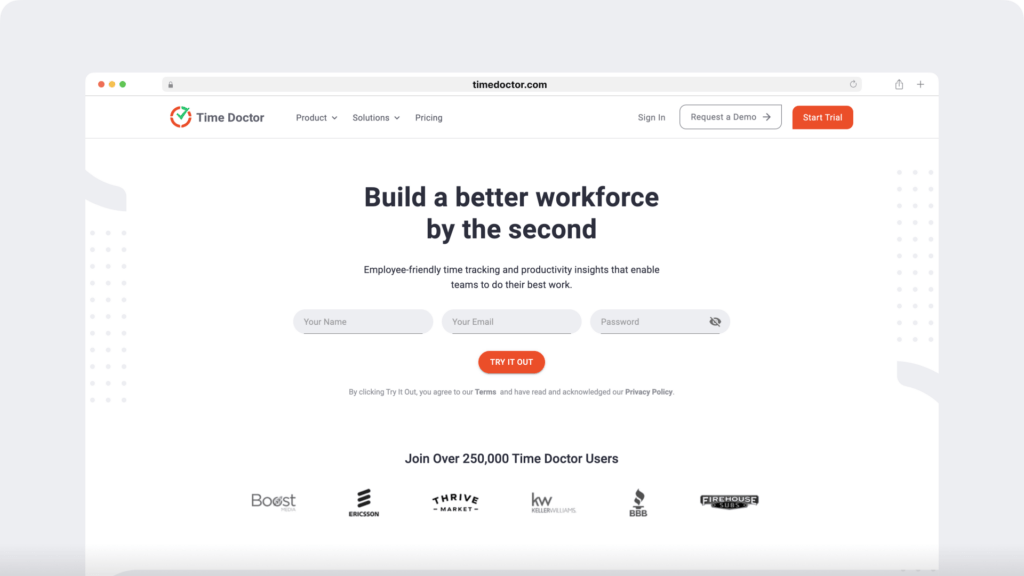
Time Doctor is a robust employee time tracking and performance management app used by major companies and small businesses.
This attendance tracking software can help you accurately track employee hours, maintain attendance data, and generate payroll with ease. It also empowers your employees to take control of their personal time management and improve productivity.
Here’s what makes Time Doctor an excellent attendance management tool:
A. Easy time tracking
Time Doctor offers both manual and automatic time tracking.
Employees can use it on their computers, tablets, and mobiles to track work hours online and offline. They can even edit their employee hours manually.
This can help managers track the clock-in and out times of every employee and determine any tardy behavior.
Moreover, it helps employers track the attendance of hourly employees and generate payrolls accordingly.
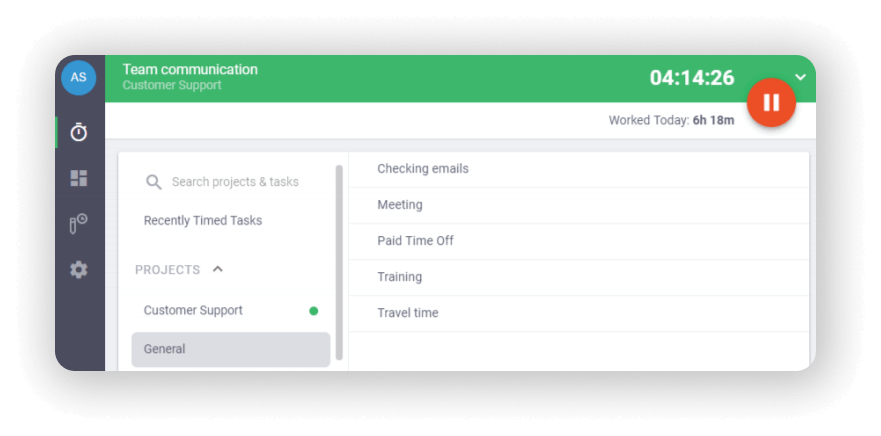
B. Detailed productivity reports
Employers and managers can access comprehensive real-time productivity reports, including attendance reports, to evaluate employee productivity.
The attendance report shows when an employee was present, absent, partially absent, or late. You can also filter a report to see employees present for a specific shift or only those who are absent or late.
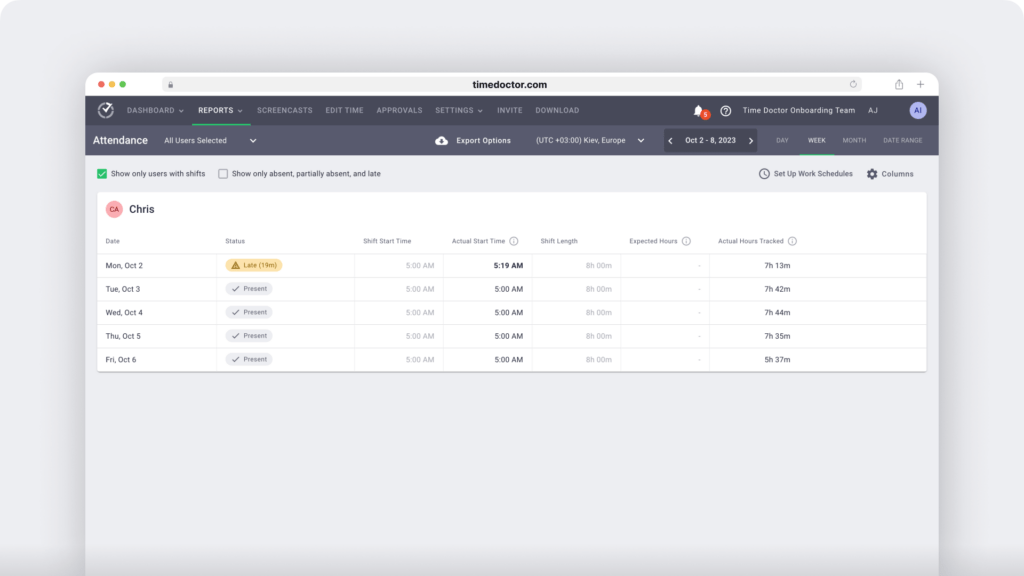
Some of the other reports that you can generate include timesheet reports, employee hours tracked, web and app usage, activity summary, etc. You can even create custom reports for any specific worker data you require.
C. Work schedule management
Managers can set schedules and shifts for the team and easily monitor which worker was late or absent for a shift. This helps you track attendance without leaving your desk.
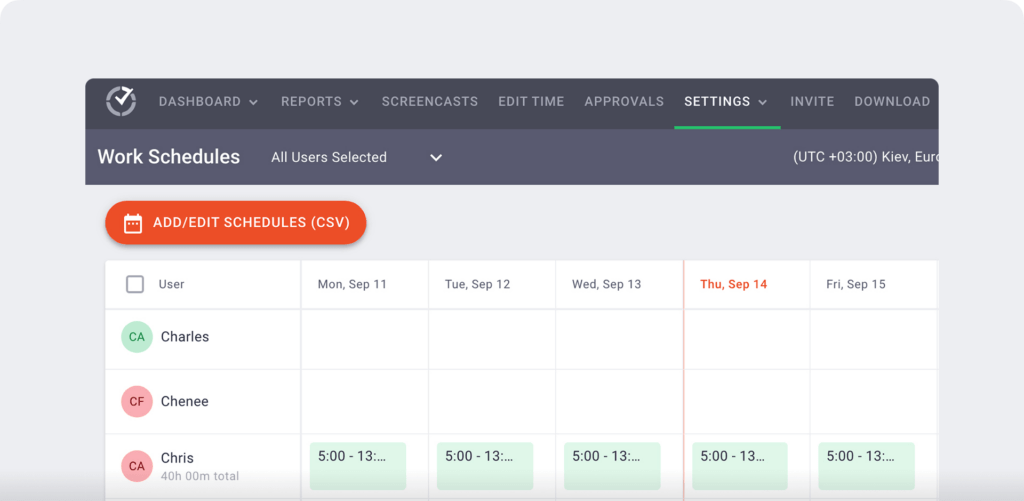
D. Payroll management
Instead of using Google Sheets or Excel templates, you can use Time Doctor to generate the payroll for your staff automatically.
You can also export payroll as a CSV file and make direct payments with PayPal, Gusto, Wise, or ADP integrations.
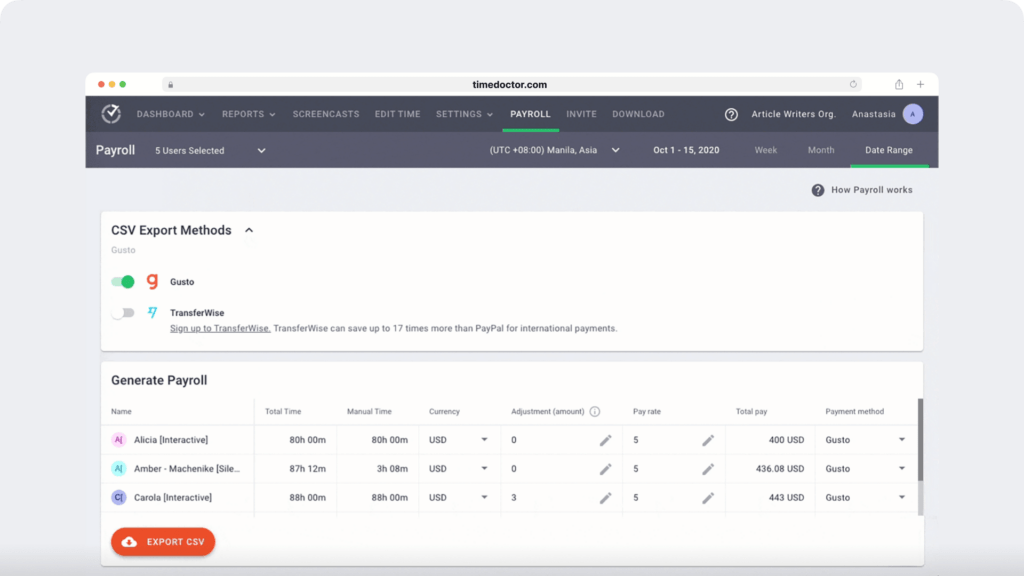
E. Chrome integration
You can ensure better workforce management by integrating Time Doctor with project management tools like Asana, Slack, and Basecamp.
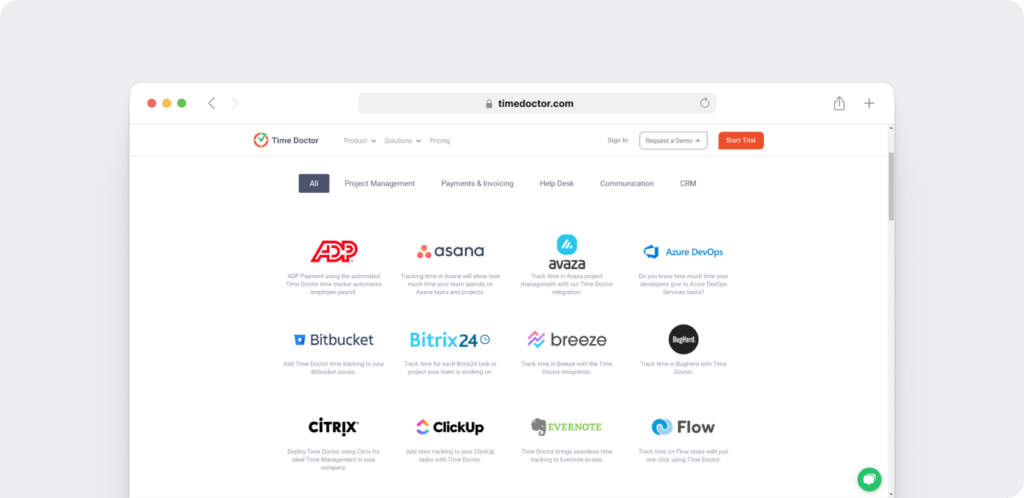
Here’s how it works:
- Download the browser extension from the Chrome Web Store.
- The extension will add a “Start/Stop” button within your selected project management tool.
- Create your task and start tracking time in the Time Doctor desktop app.
However, irrespective of the attendance tracking software you choose, you should communicate your method of tracking attendance to everyone. You should also ensure that each employee understands how to use the software.
Besides using this fantastic attendance tracking software, we also have a few tips to help you maintain regular staff attendance at your workplace.
Let’s see what these tips are.
Handy tips to maintain attendance at work
Here are some ways you can address any attendance issue:
- Have PTO (Paid Time Off) banks that employees can use for different purposes instead of having a set amount of leaves for sickness, vacation, etc. This ensures better attendance management and deals with the issue of presenteeism.
- Give incentives or attendance bonuses in the form of a cash bonus, gift cards, or extra planned time off.
- Have flexible working hours or a work-from-home policy to help employees manage their personal and professional responsibilities.
- HR professionals can suggest a wellness program, resource, or service to help employees have a work-life balance. This will not only ensure their well-being but also help them thrive socially, financially, and physically.
- Train supervisors to manage any unplanned absence and other attendance matters. Also, have dedicated HR professionals to aid supervisors and oversee overall attendance management.
- Ensure that your employee attendance policy complies with different applicable laws like the Family and Medical Leave Act (FMLA), wage and hour laws, paid sick leave laws, military leaves laws, disability discrimination laws, etc.
You can also give a few tips to your employees that can help them maintain better attendance.
- They should try to reach work early, about 15 minutes, to settle and start their day. Accordingly, they should keep enough time to get ready and leave for work.
- Employees should have a backup plan for any transportation crisis or child care needs.
- If they’re going to be late for work or need a day off, they should inform their managers as soon as possible.
- Employees should ensure that they carry their time card, name badge, etc., to work.
- They can prepare for their workday or shift a day before to manage work stress better.
Wrapping up
Having good workplace attendance is much more than your employees showing up for work physically. They should be present mentally and emotionally as well.
The first step to ensure that is to understand the factors causing the unplanned absence.
Once you figure out the root cause, you can use the guidelines mentioned in this article to effectively address your staff attendance issues and manage your workplace attendance better.

Andy is a technology & marketing leader who has delivered award-winning and world-first experiences.


